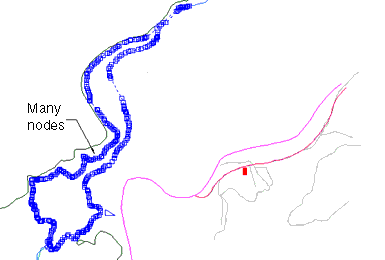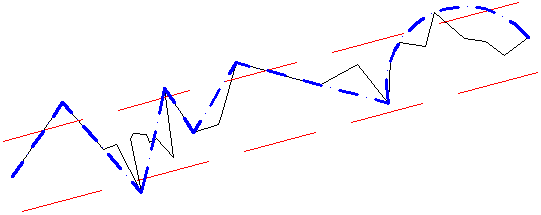When maps are digitized, edges may be defined with more detail than necessary. Use Simplify Objects to reduce unnecessary complexity in contour lines, rivers, and coastlines. Simplifying objects, also known as generalizing or weeding, reduces the number of points on a complex line.
Simplify Objects works in two dimensions, ignoring Z-values. For information about how to add and remove vertices from 3D polylines, see Weed Polylines.
When you use Simplify Objects, you simplify complex polylines by removing all interior nodes that fall within the specified tolerance width. Polyline segments falling within the same corridor are generalized into a single polyline. Branching points, dead ends, and endpoints of polylines are not generalized.

Increasing the tolerance with the Simplify Objects action removes nodes and creates a smoother profile.
Setting the Tolerance
AutoCAD Map 3D converts a set of connected polyline segments within the same tolerance into a single polyline. You specify the tolerance corridor width. The corridor values vary according to the scale of the map; maps with coordinate values of millions use larger values than those using hundreds.

The thin black line represents the original polyline, the dashed red lines the tolerance, and the blue dashes and dots show the results.
Simplifying linear objects removes as many points as possible from a polyline while keeping it within the original tolerance corridor.

A coastline simplified at different tolerance settings
For best results, follow these guidelines:
- Run Simplify Objects individually. If you perform Simplify Objects with other cleanup actions, AutoCAD Map 3D performs Simplify Objects first, regardless of its position in the Selected Actions list.
- Use deleting duplicates before simplifying linear objects.
- If your objects are lines, not plines, use Dissolve Pseudo Nodes to create a single pline.
- Simplify Objects removes width from polylines. Save your map before you simplify linear objects, so you can return to the original lines if necessary.